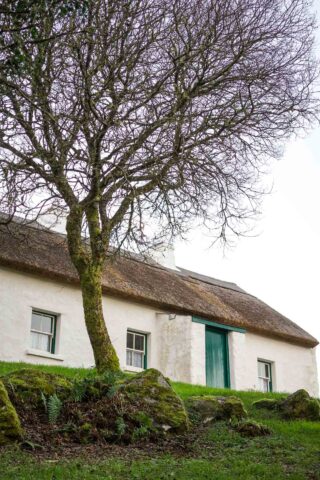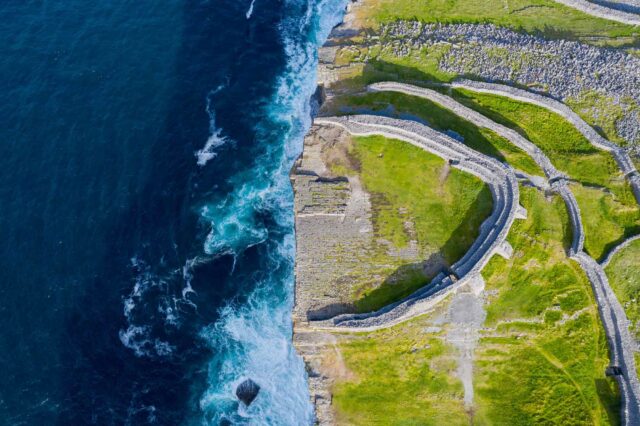Tháinig an scríbhneoir agus ceannaire Éirí Amach na Cásca 1916, Pádraic Mac Piarais, go Rosmuc don chéad uair i 1903, mar chigire le Conradh na Gaeilge. Chuaigh an ceantar agus muintir na háite go mór i bhfeidhm air. Tháinig sé air ais bliain i ndiaidh bliana suas go dtí 1915.
Pearse Cottage in Rosmuc is situated on an elevated site overlooking Loch Oiriúlach to the front, with beautiful views of the Maamturk Mountains to its side, with the Twelve Bens visible at the back of the cottage. The cottage was a summer retreat for the writer and poet Patrick Pearse for 12 years, from 1903 to 1915. It was here that he drew inspiration for his poems and short stories. It also served as a summer school for students from his bilingual school in Dublin, St Enda’s. Indeed, it was the beauty of the landscape, the strong language and culture and the people living in the area that drew him to this part of Connemara.
It was because of his love of the Irish language and culture that Pearse first travelled to Rosmuc in 1903 as an Irish-language inspector with Conradh na Gaeilge. He had a great love for the language from a very young age thanks to influences from his mother’s family. Conradh na Gaeilge was set up in 1893 as part of the Gaelic Revival of that period, with the aim of saving the language in areas like Rosmuc, where it was still spoken, strengthening it in areas where it was going into decline and reviving it in areas where it had already been lost. Patrick Pearse joined the organisation at the age of 17 and very quickly became a strong force in the language movement.
When he arrived in Rosmuc, Pearse was already fluent in the Irish language, having studied Irish throughout his education in the Christian Brothers School in Westland Row in Dublin. He had spent time in the Aran Islands in 1898 and also in the Donegal Gaeltacht, improving his spoken Irish. We can assume that 12 summers in Rosmuc added to his command of the language. Pearse is said to have been very comfortable in this part of Connemara and developed a strong affinity with the area. He did not hold back and immersed himself completely in the community. During the day, Pearse visited older people in the area, listening to the blas – the quality of their spoken Irish. Late in the evening he would be found in local homes for storytelling sessions, remaining until the early hours of the morning. He loved to listen to the language being spoken in its natural environment.

Pearse would have been inspired by the beauty of the landscape for poems and short stories such as ‘Eoghainín na nÉan’ and ‘Íosagán’, which he wrote in the area. The people he talked to and the stories he heard would also have influenced his short stories and their characters. It is thought that one main character is rooted in a sermon he heard at Sunday mass in the local church in Gortmór during his first visit in April 1903. He also references many of the local place names in his compositions.
The locals themselves would also have drawn inspiration from Pearse. One such man, Colm Ó Gaora, a member of the Irish Volunteer branch in Rosmuc, went on to write himself, documenting his own work with Conradh na Gaeilge, his involvement in the 1916 Rebellion and the War of Independence. Pearse was central in setting up the branch and personally manoeuvred and drilled the men around the area. He invited them to attend the funeral of Jeremiah O’Donovan Rossa in Glasnevin, where he delivered a graveside oration for the well-known Fenian on 1 August 1915. He wrote the famous speech at the cottage during his holiday that summer. It marks the last thing that he worked on and his last visit to the area.
One of the aims of Conradh na Gaeilge was to bring the Irish language back onto the curriculum for all students. Pearse went a step further opening a bilingual school, St Enda’s, in Dublin. He saw the importance and benefit of bringing students from English-speaking areas to the Irish-speaking community to be completely immersed in the language and culture. The cottage is a good size, by the standards of the time, yet it could not accommodate large groups of students. Tents were erected around it. The students were instructed through formal classes with Pearse and they had the benefit of the wider area as a living classroom, in which they could listen to the language and experience the culture.

Over a hundred years later, thousands of second- and third-level students come to the Gaeltacht, following in the footsteps of those early students who came to Rosmuc. Pearse also offered scholarships to locals to attend his school in Dublin. It was of course, a great opportunity. Fluent Irish speakers attended the boarding school, mixing with students from English-speaking backgrounds. Such social and cultural interactions would have been of considerable benefit to their education.
Following Pearse’s execution for his part in the 1916 Rebellion, the cottage at Rosmuc remained unoccupied for a number of years. It was set on fire by the Black and Tans in 1921 during the War of Independence, but the locals renovated it as a mark of respect for Pearse soon afterwards and it became a rental property. Pearse’s mother, Margaret, bequeathed the cottage to the state before her death in 1932, with the official handover taking place when the last remaining member of the family, Pearse’s sister, also called Margaret, died in 1968.
Ever since, the site has been maintained and made available to the public by the Office of Public Works, with visitors from all over the world coming to learn about Patrick Pearse and his connections to Rosmuc. A new visitor centre, Ionad Cultúrtha an Phiarsaigh, Conamara, built to mark the 100th anniversary of the 1916 Rising, adds to the visitor experience. Patrick Pearse was well regarded throughout Rosmuc during the 12 years that he spent visiting the area, and great pride in his connections with Connemara persists to the present day.

